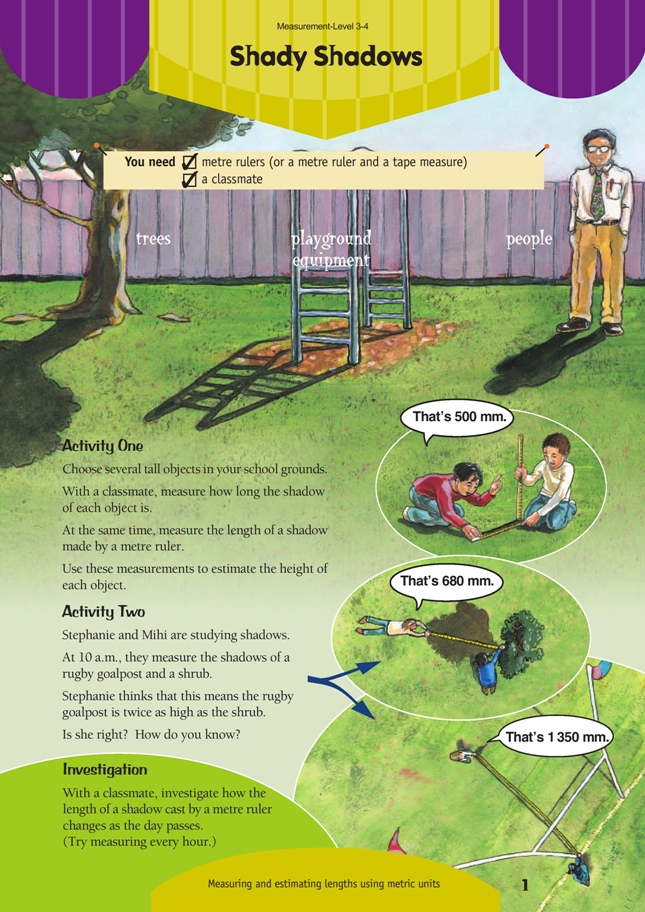This is a level 3 measurement activity from the Figure it Out series.
A PDF of the student activity is included.
Click on the image to enlarge it. Click again to close. Download PDF (494 KB)
estimate and measure metric lengths
FIO, Level 3-4, Measurement, Shady Shadows, page 1
classmate
Activity One
In this activity, students estimate the height of an object by comparing the length of its shadow with the length of a shadow of an object with a known height (in this case, a metric ruler held vertically).
The students will need to measure the shadow of the metre ruler carefully. They will need to keep the ruler vertical because only a slight change of angle can cause a large error. They could do this by holding a plumb line (a string with a sinker at the bottom) beside the ruler or using a carpenter’s level or large classroom set square.
The metre ruler in the example in the students’ book is twice as long as its shadow. The length of the shadows of the other objects measured will be in the same proportion to the height of the object as the ruler is to its shadow.
So, if the other object has a shadow of 600 millimetres (measured at the same time of day), it must be 2 x 600 = 1 200 millimetres high.
The students may think of this in a number of ways. For example:
“Because the ruler’s shadow is half as long as the ruler, the object must be twice as long as its shadow.”
“If 600 millimetres is 1/2, then one whole would be 1 200 millimetres (600 x 2).”
When the students are measuring actual shadows, the numbers may not be quite so neat, so they may need to round their measurements to estimate the height of the object. You could ask them, “About how many times bigger than its shadow is the metre ruler? This is how many times bigger than its shadow the object will be.”
If the students want accurate results, they can use a calculator to divide the metre ruler by its shadow to get the proportion. For example, if the shadow of the metre ruler is 270 millimetres, 1 000 ÷ 270 = 3.7, so all the objects measured at the same time that day will be 3.7 times bigger than their shadows.
If the students measure objects late in the day, they may find that the shadows are longer than the height of the object.
Activity Two
Stephanie is correct because the shadows were measured at the same time of day and the length of the shadow of the tree is approximately half the length of the shadow of the goalpost.
You can show this to the students using a metre ruler and a spring peg. Clip the peg halfway along the ruler. Hold the ruler vertically and show the students that the peg’s shadow is still halfway up the ruler’s shadow. Tilt the ruler to change the shadow length. Note that the peg’s shadow is still at the halfway position. Therefore, if one object is half the height of another object, its shadow will always be half the length of the shadow of the other object (if measured at the same time of the same day).
Investigation
Once again, the students need to keep the metre ruler vertical for all measures (see Activity One). They could measure the shadow at regular intervals, such as every hour. They could then graph their results to see how the shadow changes with time.
The students should be able to see that the shadow is shorter in the middle of the day (allowing for daylight saving if necessary) and longer at the beginning and the end of the day.
See also Shadows, Book 9 in the Building Science Concepts series (Ministry of Education, 2001).
Answers to Activity
Activity One
Answers will vary, but they should be based on the ratio of the ruler to its shadow.
Activity Two
Stephanie is right because 680 x 2 = 1 360, which is very close to 1 350 mm, and the shadows were measured at the same time of the day.
Investigation
Answers will vary, but you should find that the shadow gets smaller in the middle of the day and then gradually gets longer again

